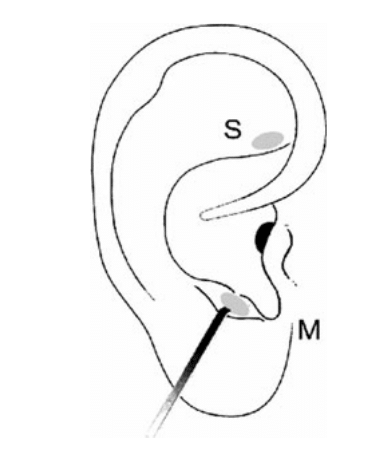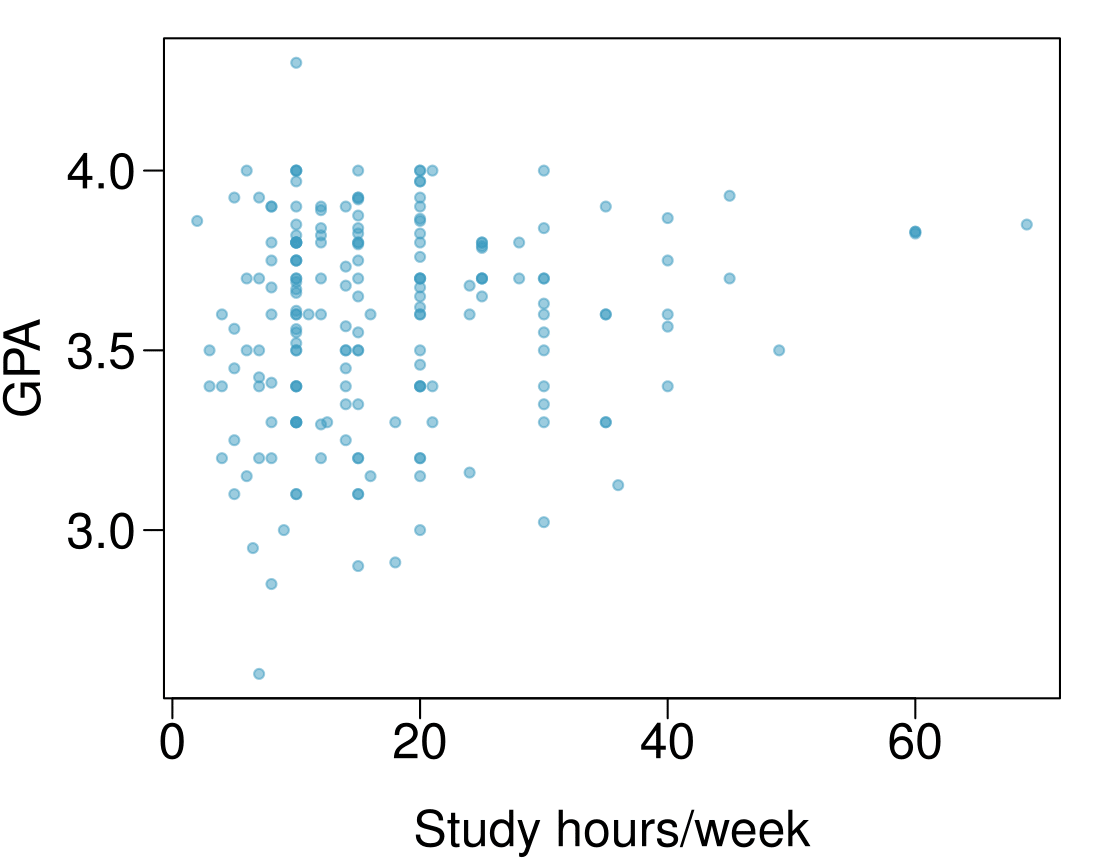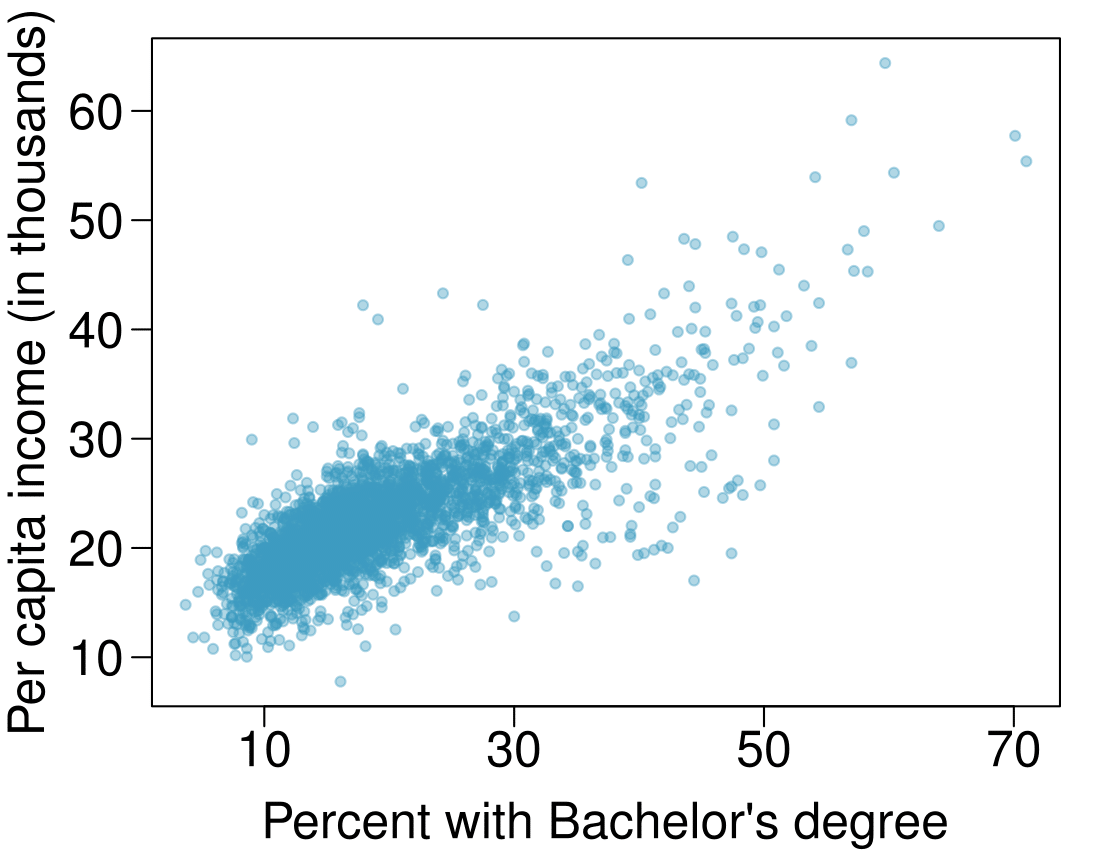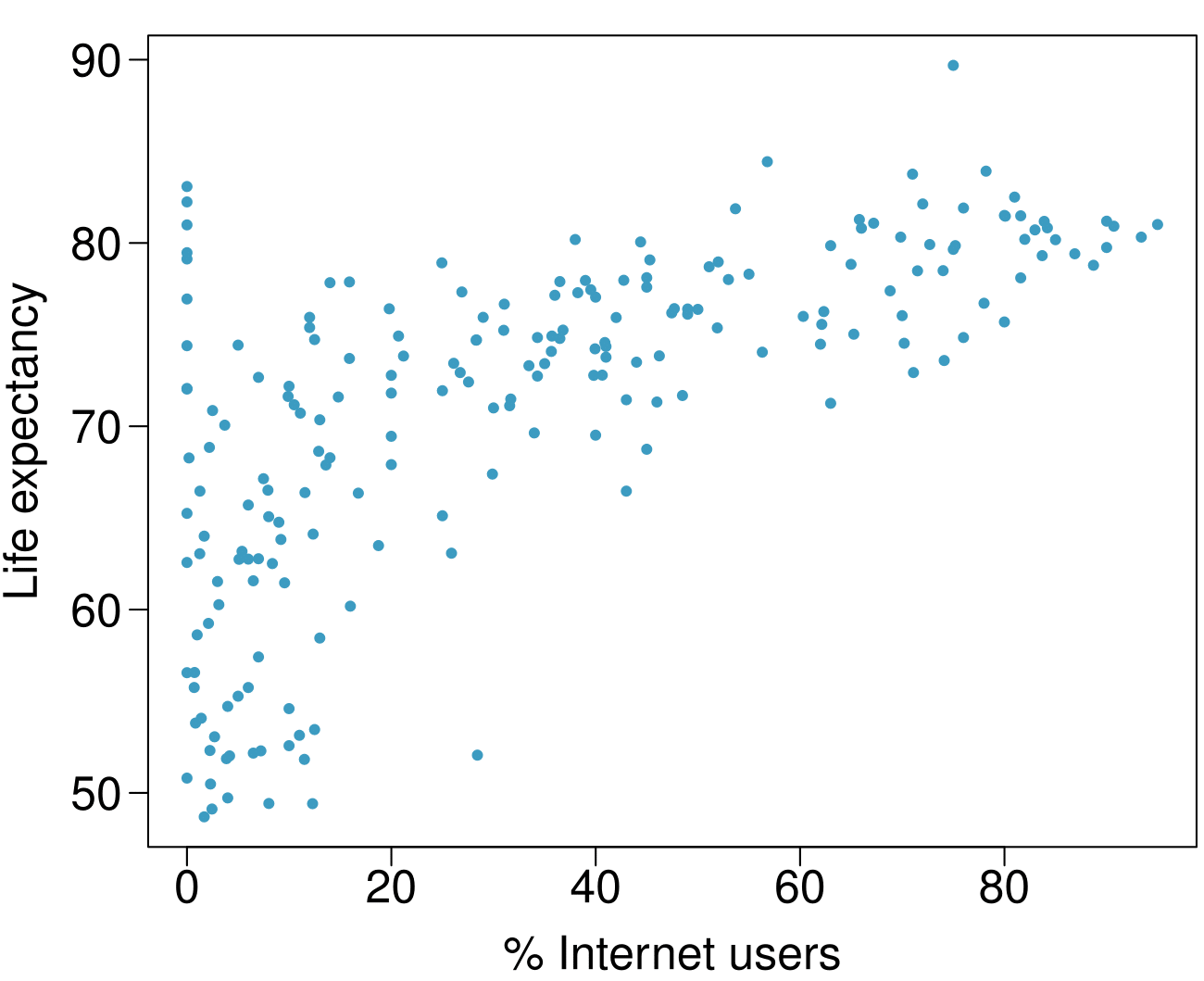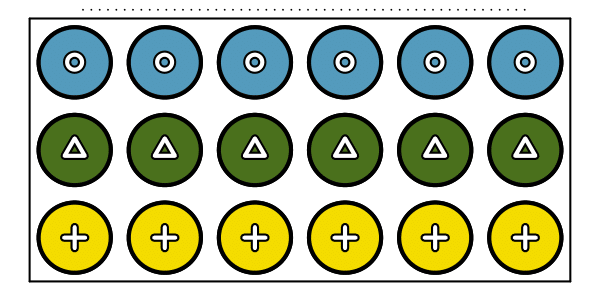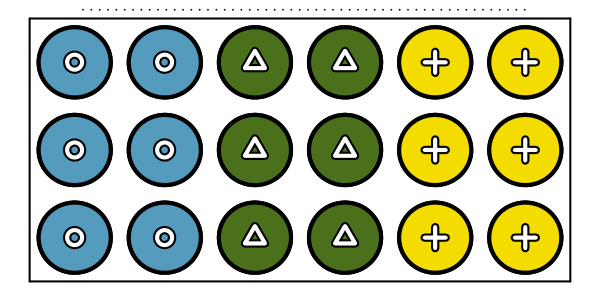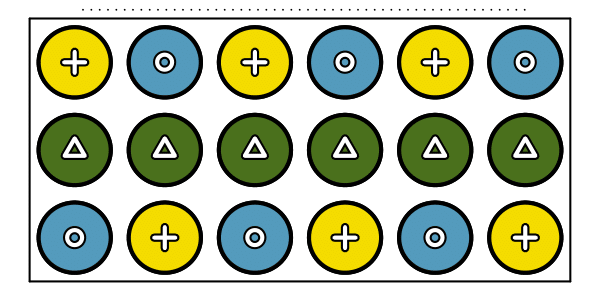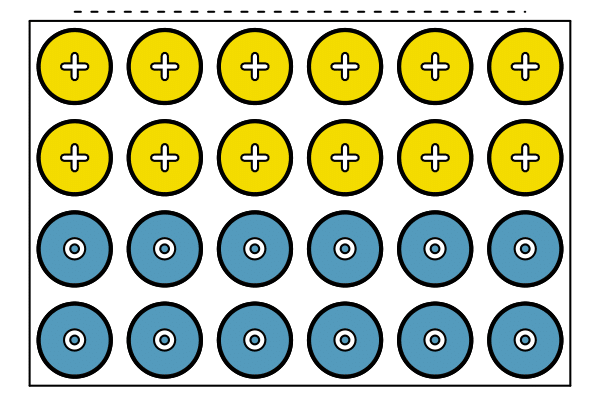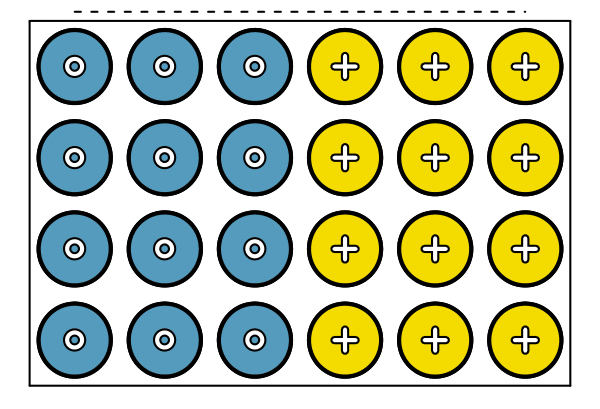25 Stressed out, Part II
In a study evaluating the relationship between stress and muscle cramps, half the subjects are randomly assigned to be exposed to increased stress by being placed into an elevator that falls rapidly and stops abruptly and the other half are left at no or baseline stress.
- What type of study is this? Answer
- Can this study be used to conclude a causal relationship between increased stress and muscle cramps? Answer
26 Light and exam performance
A study is designed to test the effect of light level on exam performance of students. The researcher believes that light levels might have different effects on males and females, so wants to make sure both are equally represented in each treatment. The treatments are fluorescent overhead lighting, yellow overhead lighting, no overhead lighting (only desk lamps).
What is the response variable?
What is the explanatory variable? What are its levels?
What is the blocking variable? What are its levels?
27 Vitamin supplements
In order to assess the effectiveness of taking large doses of vitamin C in reducing the duration of the common cold, researchers recruited 400 healthy volunteers from staff and students at a university. A quarter of the patients were assigned a placebo, and the rest were evenly divided between 1g Vitamin C, 3g Vitamin C, or 3g Vitamin C plus additives to be taken at onset of a cold for the following two days. All tablets had identical appearance and packaging. The nurses who handed the prescribed pills to the patients knew which patient received which treatment, but the researchers assessing the patients when they were sick did not. No significant differences were observed in any measure of cold duration or severity between the four medication groups, and the placebo group had the shortest duration of symptoms. 15
- Was this an experiment or an observational study? Why? Answer
Experiment, as the treatment was assigned to each patient.
- What are the explanatory and response variables in this study? Answer
Response: Duration of the cold. Explanatory: Treatment, with 4 levels: placebo, 1g, 3g, 3g with additives.
- Were the patients blinded to their treatment? Answer
- Was this study double-blind? Answer
Double-blind with respect to the researchers evaluating the patients, but the nurses who briefly interacted with patients during the distribution of the medication were not blinded. We could say the study was partly double-blind.
- Participants are ultimately able to choose whether or not to use the pills prescribed to them. We might expect that not all of them will adhere and take their pills. Does this introduce a confounding variable to the study? Explain your reasoning. Answer
No. The patients were randomly assigned to treatment groups and were blinded, so we would expect about an equal number of patients in each group to not adhere to the treatment.
28 Light, noise, and exam performance
A study is designed to test the effect of light level and noise level on exam performance of students. The researcher believes that light and noise levels might have different effects on males and females, so wants to make sure both are equally represented in each treatment. The light treatments considered are fluorescent overhead lighting, yellow overhead lighting, no overhead lighting (only desk lamps). The noise treatments considered are no noise, construction noise, and human chatter noise.
What type of study is this?
How many factors are considered in this study? Identify them, and describe their levels.
What is the role of the sex variable in this study?
29 Music and learning
You would like to conduct an experiment in class to see if students learn better if they study without any music, with music that has no lyrics (instrumental), or with music that has lyrics. Briefly outline a design for this study. AnswerRecruit 30 friends and randomly assign them to three groups: no music, instrumental music, and music with lyrics. Have each participant read a passage to learn about a new concept, and then give them a short quiz assessing what they have learned. Compare the number of questions participants got correct on average across the three groups.
30 Soda preference
You would like to conduct an experiment in class to see if your classmates prefer the taste of regular Coke or Diet Coke. Briefly outline a design for this study.
31 Exercise and mental health
A researcher is interested in the effects of exercise on mental health and he proposes the following study: Use stratified random sampling to ensure representative proportions of 18-30, 31-40 and 41-55 year olds from the population. Next, randomly assign half the subjects from each age group to exercise twice a week, and instruct the rest not to exercise. Conduct a mental health exam at the beginning and at the end of the study, and compare the results.
- What type of study is this? Answer
- What are the treatment and control groups in this study? Answer
Treatment is exercise twice a week. Control is no exercise.
- Does this study make use of blocking? If so, what is the blocking variable? Answer
Yes, the blocking variable is age.
- Does this study make use of blinding? Answer
- Comment on whether or not the results of the study can be used to establish a causal relationship between exercise and mental health, and indicate whether or not the conclusions can be generalized to the population at large. Answer
This is an experiment, so a causal conclusion is reasonable. Since the sample is random, the conclusion can be generalized to the population at large. However, we must consider that a placebo effect is possible.
- Suppose you are given the task of determining if this proposed study should get funding. Would you have any reservations about the study proposal? Answer
Yes. Randomly sampled people should not be required to participate in a clinical trial, and there are also ethical concerns about the plan to instruct one group not to participate in a healthy behavior, which in this case is exercise.
32 Chia seeds and weight loss
Chia Pets — those terra-cotta figurines that sprout fuzzy green hair — made the chia plant a household name. But chia has gained an entirely new reputation as a diet supplement. In one 2009 study, a team of researchers recruited 38 men and divided them randomly into two groups: treatment or control. They also recruited 38 women, and they randomly placed half of these participants into the treatment group and the other half into the control group. One group was given 25 grams of chia seeds twice a day, and the other was given a placebo. The subjects volunteered to be a part of the study. After 12 weeks, the scientists found no significant difference between the groups in appetite or weight loss. 16
What type of study is this?
What are the experimental and control treatments in this study?
Has blocking been used in this study? If so, what is the blocking variable?
Has blinding been used in this study?
Comment on whether or not we can make a causal statement, and indicate whether or not we can generalize the conclusion to the population at large.
33 Multitaskers, Part I
Researchers studying the effect of TV watching while studying on school performance conducted the following studies. For each study determine (i) the type of study (observational or experiment), (ii) if there is random sampling, (iii) if there is random assignment, (iv) state the scope of the conclusions of the study, and (v) note if stratifying, blocking, or neither of these techniques were used in the study.
- Researchers randomly sampled 100 high school students and asked them whether or not they watched TV while studying. They found that the mean grade point average of students who did not watch TV while studying was significantly higher than the mean grade point average of students who did watch TV while studying. Answer
(i) Observational study.
(ii) There is random sampling.
(iii) There is no random assignment.
(iv) Since only random sampling from a known population is performed, one may infer the characteristics of the sample tend to mirror corresponding characteristics of the population. Therefore, we can say that among high school students those who do not watch TV while doing homework tend to do better on average. However we cannot infer causation based on this study.
(v) Neither stratifying nor blocking was used in this study.
- Researchers randomly sampled 50 female and 50 male high school students and asked them whether or not they watched TV while studying. They found that the mean grade point average of both males and females who did not watch TV while doing homework was significantly higher than the mean grade point average of students who did watch TV while doing homework. Answer
(i) Observational study.
(ii) There is random sampling.
(iii) There is no random assignment.
(iv) Since only random sampling from a known population is performed, one may infer the characteristics of the sample tend to mirror corresponding characteristics of the population. Therefore, we can say that among high school males and females those who do not watch TV while doing homework tend to do better on average. However we cannot infer causation based on this study.
(v) Stratifying (separating into groups during the process of sampling) is used but no blocking.
- Researchers randomly sampled 100 high school students and randomly assigned them into two study groups. Throughout the school year, one group was told to study in a room with a TV on while the other was told to study in silence. At the end of the year the researchers compared the grade point averages of the two groups and found that the mean grade point average of students who did not watch TV while studying was significantly higher than the grade point average of students who did watch TV while studying. Answer
(i) Experiment.
(ii) There is random sampling.
(iii) There is random assignment.
(iv) Since both random sampling and random assignment to groups are performed, one may draw cause-effect inferences about the sample results, as well as generalize to the larger population from which the sample was drawn. Therefore, we can say that there appears to be a cause-and-effect relationship between watching TV while doing homework and low grade point averages.
(v) Neither stratifying nor blocking was used in this study.
34 Multitaskers, Part II
Researchers investigating the effect of studying while watching TV on school performance conducted the following studies. For each study determine (i) the type of study (observational or experiment), (ii) if there is random sampling, (iii) if there is random assignment, (iv) state the scope of the conclusions of the study, and (v) note if stratifying, blocking, or neither of these techniques were used in the study.
Researchers randomly sampled 50 female and 50 male high school students. Half of the females and half of the males were randomly assigned to study in a room with a TV and the remainder studied without a TV. They found that the mean grade point average of both males and females who did not watch TV while studying was significantly higher than those who did watch TV while studying.
Researchers surveyed the first 100 students who showed up to prom. They found that the mean grade point average of students who did not watch TV while studying was higher than the mean grade point average for students who did watch TV while studying.
Researchers surveyed the first 50 male and 50 female students who showed up to prom. They found that the mean grade point average of both males and females who did not watch TV while doing homework was higher than the mean grade point average of students who did watch TV while studying.
35 Multitaskers, Part III
Suppose a friend of yours wants to design his own study for evaluating the effect of TV watching on school performance. He proposes comparing the grade point averages of everyone in his homeroom class who do and do not watch TV while doing homework, and extending the results of this study to draw conclusions about all high schoolers. Indicate any mistakes with this design, keeping in mind that the goal of the study is to assess the causal relationship between TV watching and school performance for high schoolers. AnswerA sample of everyone in your homeroom class is not a random sample of all high schoolers, therefore findings from this study should not be generalized to all high schoolers. Also, this is an observational study with no random assignment, therefore causal inferences cannot be drawn.
36 Multitaskers, Part IV
Suppose two friends of yours want to design their own study for evaluating the effect of TV watching on school performance. They propose the following designs. Indicate any mistakes with these designs, keeping in mind that the goal of the study is to assess the causal relationship between TV watching and school performance for high schoolers.
Randomly sample 100 students from the entire school. Reserve two classrooms for a study session and the first 50 people that show up get assigned to the room where the TV will be on and the rest to the room where they can study in silence for a final exam. Then compare the average grades of the two groups at the end of the semester.
Age and involvement in extracurricular activities may be factors that affect the academic performance of a student, so these characteristics should be blocked for when studying the effect of watching TV while studying. To achieve this aim, sample 10 first-years, 10 sophomores, 10 juniors, and 10 seniors, 5 of which are heavily involved with extracurricular activities and 5 of which are not from each class. Then ask them whether they watch TV while they study, and compare the average GPAs of those who do and do not.
37 Running on electrolytes
Suppose you would like to design a study evaluating whether consuming a sports drink that replenishes electrolytes can make you run faster. You were able to recruit 50 students to participate in your study. Describe how you can use matched pairs design and blinding for this study. AnswerMatch subjects on attributes that might be associated with running faster: age, height, weight, fitness level, running experience, etc. Then, randomly assign one student from each pair to consume a sports drink that replenishes electrolytes and the other to consume a placebo drink (a drink that looks and tastes the same but does not replenish electrolytes). Then, time the students running the same pre-specified distance (e.g. 1 mile) and compare the average finishing times for the two groups.
38 Improving life satisfaction
In a study evaluating the effectiveness of a positive psychology group intervention, forty middle schoolers who were identified as being less than delighted with their lives (reported life satisfaction scores between 1 and 6 on a 7-point scale) were randomly assigned to receive the intervention (treatment) or not receive the intervention (control). These students were first matched on attributes such as sex, socioeconomic group, race/ethnicity, and age, such that each student in the treatment group had a matched counterpart in the control group. Researchers found that life satisfaction of students in the intervention group increased significantly, while the control group declined during the same period (although this change was not statistically significant). 17
What type of study is this?
What type of design is used in this study?
Can the results of this study be used to establish a causal link between the intervention and increased life satisfaction in middle schoolers?
39 Alfalfa plants
Researchers were interested in the effect that acid has on the growth rate of alfalfa plants. They created three treatment groups in an experiment: low acid (\(+\)), high acid (\(\triangle\)), and control (Ο). The alfalfa plants were grown in a Styrofoam cups arranged near a window and the height of the alfalfa plants was measured after five days of growth. The experiment consisted of 6 cups for each of the 3 treatments, for a total of 18 observations. Which of the following designs is preferable? Note that the dotted line indicates the location of the window. Explain your reasoning. AnswerDesign B is the most appropriate since there are an equal number of cups from each group at each of the possible distances from the window (2 cups from each group are next to the window, 2 cups from each group are middle distance from the window, 2 cups from each group are far from the window). This is important since the amount of sunlight is likely an important factor in the plants' growth.
40 Chocolate chip cookies
We would like to compare two cookie recipes, one from a popular recipe website and another from the back of a bag of chocolate chips. We will bake 24 cookies, 12 of each type, and then have a friend rate each cookie on a scale of 1 to 10. Both sets of cookies are supposed to be baked for the same amount of time and at the same temperature: 9 minutes at 350°F. We will use an old oven available to students in the school, which tends to overheat a little near the oven's back.
Would we bias our results if we cooked one type of cookie first and the other second?
We instead decide to bake each batch simultaneously on the same tray, and decide to block for proximity to the back of the oven. Two blocking schemes shown below are under consideration. For each scheme, cookies made with the recipe from the website are indicated with a \(+\) and cookies made with the other recipe are indicated with a Ο . The dashed line marks the back of the oven. Which of the blocking schemes, A or B, is better for this experiment? Explain your answer.
How can the blocking scheme you chose in the previous part be improved?
